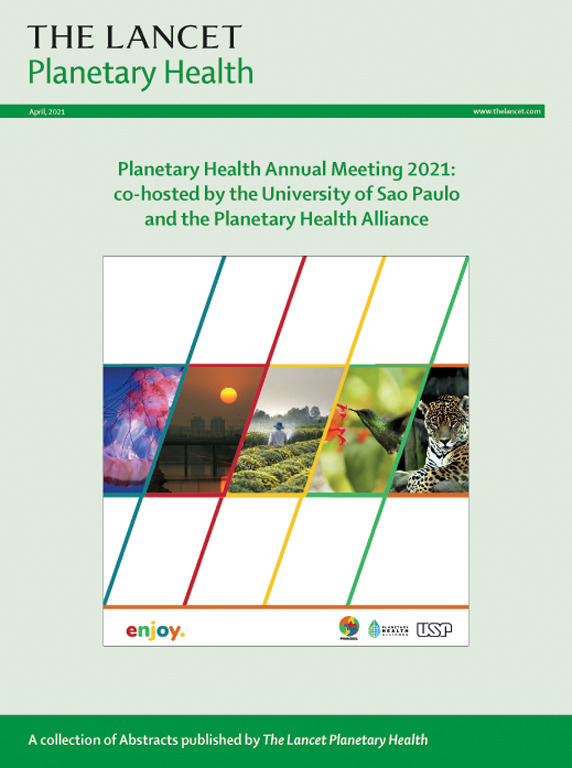新型住宅设计(星级住宅)对坦桑尼亚农村室内疟疾蚊子丰度的影响:一项开放标签、家庭、随机对照试验的次要结果
IF 21.6
1区 医学
Q1 ENVIRONMENTAL SCIENCES
引用次数: 0
摘要
筛查所可以减少撒哈拉以南非洲的疟疾传播。我们的研究评估了与坦桑尼亚Mtwara的传统房屋相比,一种位于二楼的卧室的新型遮蔽房屋设计(星级住宅)是否减少了室内蚊子的数量。方法采用开放标签、家庭、随机对照试验,于2022年1月5日至2023年12月20日对北京市59个村庄的110户星级民宅和110户邻近传统民宅进行室内蚊虫密度评估。每7周使用美国疾病控制中心的诱蚊灯收集蚊子。采用PCR法鉴定冈比亚按蚊和山羊按蚊,ELISA法检测恶性疟原虫孢子子。记录夜间温度、二氧化碳浓度和开门时间。使用广义线性混合效应模型分析了研究组之间的差异。该试验已在ClinicalTrials.gov注册(NCT04529434)。在9290只蚊中,冈比亚伊蚊1899只,乌氏伊蚊69只,库蚊7322种,以致倦库蚊为主。星级家庭的冈比亚感染减少51%(调整风险比[RR] 0.49, 95% CI 0.35 ~ 0.69;p = 0.0001),库蚊种类减少61% (RR = 0.39, 0.32 ~ 0.48;P< 0.0001)。夜间,星屋温度降低0.5°C (95% CI为0.2 ~ 0.9;p=0·010),CO2浓度相似(-7 ppm, 95% CI -19至6;P = 0.285),室外门打开时间比传统房屋少53% (7.5 min/h vs 16.2 min/h);术;0·0001)。与传统房屋相比,star房屋减少了室内蚊子数量和疟疾传播风险,证明了在非洲农村,经过良好过滤和透气性的房屋具有保护作用。新加坡华子基金会。本文章由计算机程序翻译,如有差异,请以英文原文为准。
Effect of a novel house design (star home) on indoor malaria mosquito abundance in rural Tanzania: secondary outcomes of an open-label, household, randomised controlled trial
Background
Screening houses can reduce malaria transmission in sub-Saharan Africa. Our study evaluated whether a novel screened house design (star home) with bedrooms on the second storey reduced indoor mosquito abundance compared with traditional houses in Mtwara, Tanzania.
Methods
In this open-label, household, randomised controlled trial, indoor mosquito abundance was assessed in 110 star homes and 110 neighbouring traditional houses in 59 villages from Jan 5, 2022, to Dec 20, 2023. Mosquitoes were collected using US Centers for Disease Control light traps every 7 weeks. Anopheles gambiae and Anopheles funestus species were identified using PCR and Plasmodium falciparum sporozoites detected using ELISA. Nightly temperature, CO2 concentrations, and duration of door opening was recorded. Differences between study groups were analysed using generalised linear mixed-effects models. The trial is registered with ClinicalTrials.gov (NCT04529434).
Findings
Of 9290 mosquitoes collected, 1899 were A gambiae, 69 were A funestus, and 7322 Culex species, mainly Culex quinquefasciatus. Star homes had 51% less A gambiae (adjusted risk ratio [RR] 0·49, 95% CI 0·35 to 0·69; p<0·0001) and 61% less Culex species (RR 0·39, 0·32 to 0·48; p<0·0001) than traditional houses. At night, star homes were 0·5°C cooler (95% CI 0·2 to 0·9; p=0·010), with similar concentrations of CO2 (–7 ppm, 95% CI –19 to 6; p=0·285) and had external doors open 53% less time than traditional houses (7·5 min/h vs 16·2 min/h; p<0·0001).
Interpretation
Star homes reduced indoor mosquito abundance and malaria transmission risk compared with traditional houses, demonstrating the protective efficacy of houses that are well screened and air permeable in rural Africa.
Funding
Hanako Foundation, Singapore.
求助全文
通过发布文献求助,成功后即可免费获取论文全文。
去求助
来源期刊

Lancet Planetary Health
Multiple-
CiteScore
28.40
自引率
2.30%
发文量
272
审稿时长
8 weeks
期刊介绍:
The Lancet Planetary Health is a gold Open Access journal dedicated to investigating and addressing the multifaceted determinants of healthy human civilizations and their impact on natural systems. Positioned as a key player in sustainable development, the journal covers a broad, interdisciplinary scope, encompassing areas such as poverty, nutrition, gender equity, water and sanitation, energy, economic growth, industrialization, inequality, urbanization, human consumption and production, climate change, ocean health, land use, peace, and justice.
With a commitment to publishing high-quality research, comment, and correspondence, it aims to be the leading journal for sustainable development in the face of unprecedented dangers and threats.
 求助内容:
求助内容: 应助结果提醒方式:
应助结果提醒方式:


